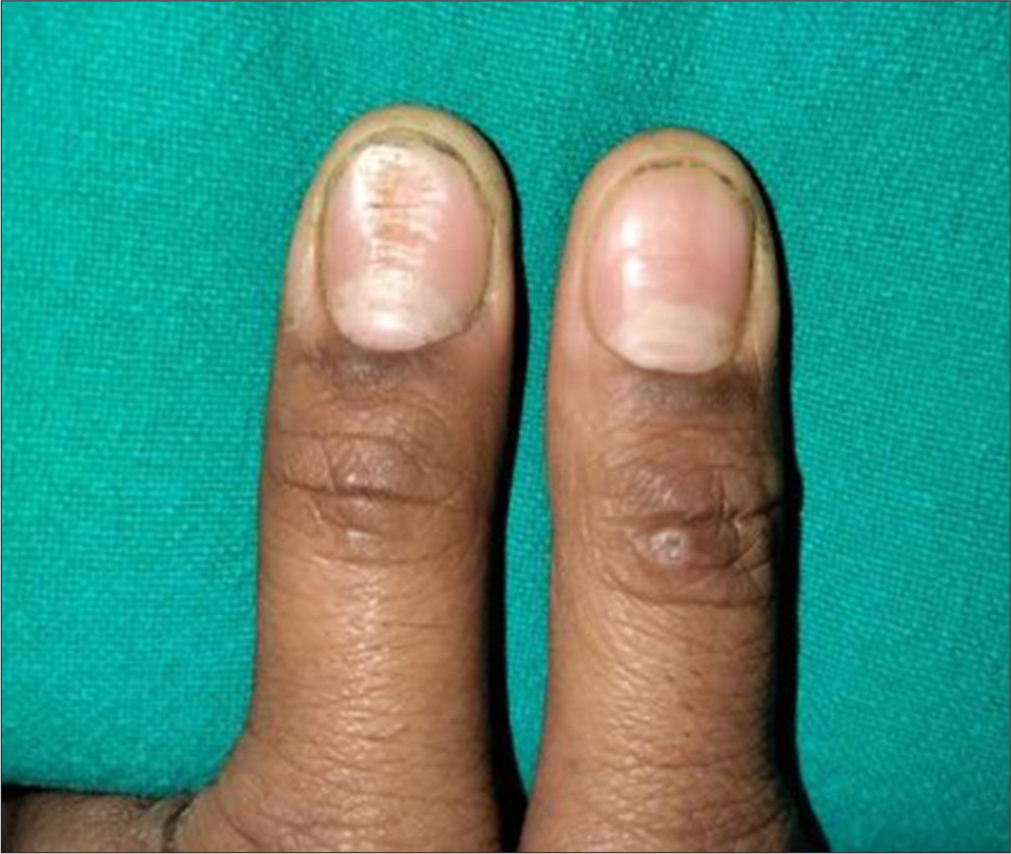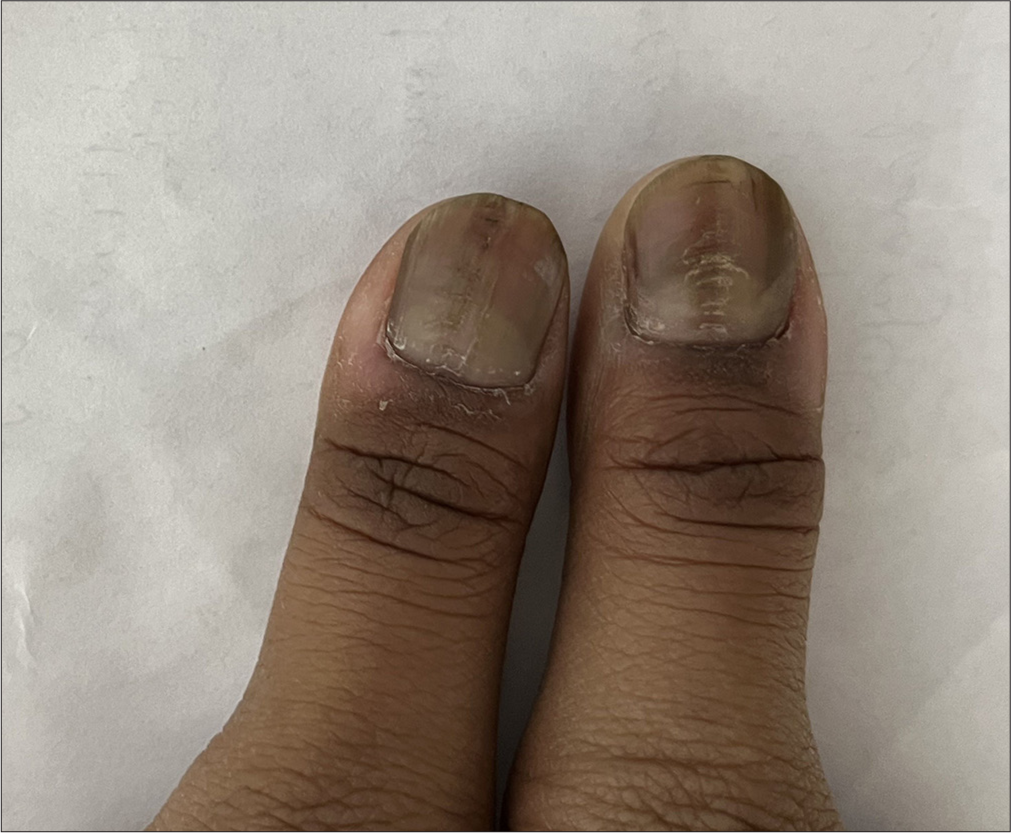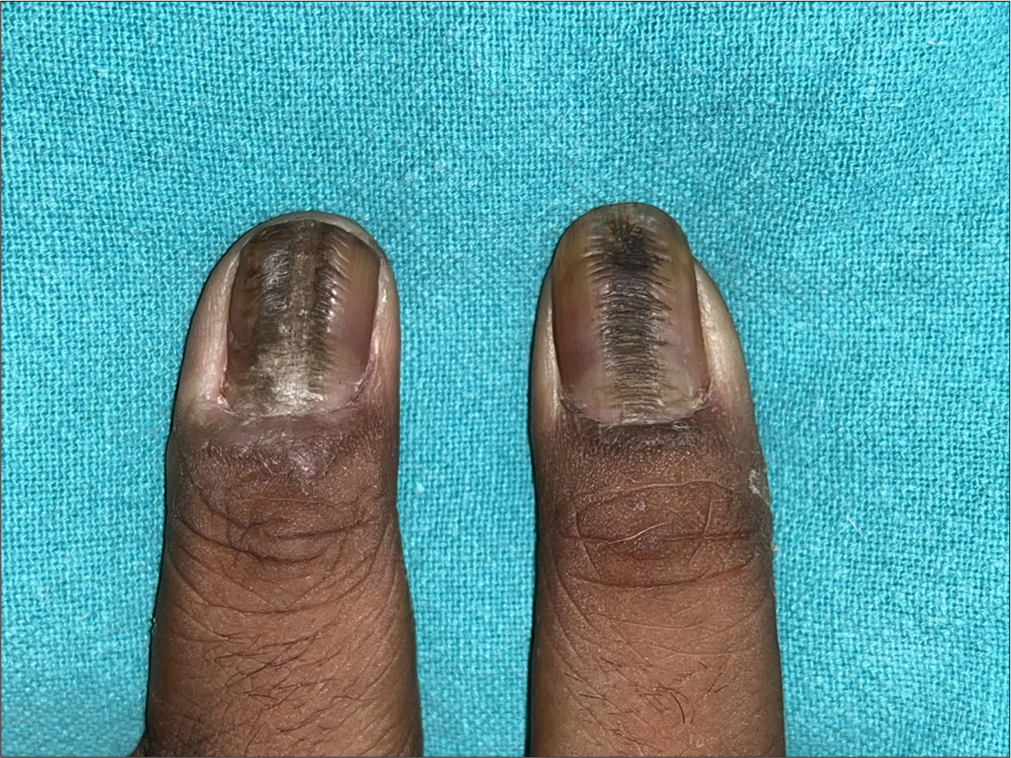Translate this page into:
‘Washboard nails’ secondary to habit-tic deformity versus median canaliform dystrophy of Heller: The morpho-diagnostic conundrum
*Corresponding author: Naveen Kumar Kansal, Department of Dermatology and Venereology, All India Institute of Medical Sciences, Rishikesh, Uttarakhand, India. kansalnaveen@gmail.com
-
Received: ,
Accepted: ,
How to cite this article: Kansal NK, Kumar N, Bhatia R, Sushantika S. ‘Washboard nails’ secondary to habit-tic deformity versus median canaliform dystrophy of Heller: The morpho-diagnostic conundrum. J Onychol Nail Surg. 2025;2:54-6. doi: 10.25259/JONS_4_2025
Dear Editor,
Habit-tic deformity of the nail is a form of dystrophy caused by habitual external trauma to the nail matrix.[1,2] Thumbnails are most commonly involved, with resultant midline nail changes. Classically seen in adults, it occurs secondary to a habitual tendency to push back the cuticle, though the patient is not aware of her/his behaviour. Usually, fingernail involvement is seen; however, toenails may also be affected.[3] The aetiology of this condition is ‘body-focused repetitive behaviour (BFRB)’, but the patient is not aware of this behaviour. Clinical presentation is with a ‘central linear depression surrounded by parallel transverse ridges running from the proximal to the distal end’. This appearance is referred to as ‘washboard nails’ due to its resemblance to a washboard. The cuticle is damaged and/or absent, with a loss of adhesion between the proximal nail fold and the nail plate. This may expose the distal matrix, and friction usually leads to a loss of sheen over the nail plate.[4] We recently came across three cases with this condition [Figures 1-3]. The details are depicted in Table 1.

- Washboard nail deformity of the left thumb nail in a 27-year-old male patient.

- Washboard nails bilaterally in a 14-year-old female patient.

- Washboard nail bilaterally in a 34-year-old male patient.
| Clinical parameter | Patient 1 | Patient 2 | Patient 3 |
|---|---|---|---|
| 1. Age, Gender | 27 years, male | 14 years, female | 34 years, male |
| 2. Occupation | Office worker | Student | Manual worker |
| 3. Involvement | Unilateral | Bilateral | Bilateral |
| 4. Cuticular involvement | Minimal | Significant involvement | Present |
| 5. History of contact with allergen/irritant | Absent | Absent | Absent |
| 6. History of habitual nail picking or trauma | Denied by the patient | Denied by the patient | No apparent history; as the patient was a manual worker, trauma may be associated |
| 7. KOH examination | No fungal elements seen | No fungal elements seen | No fungal elements seen |
| 8. Treatment | Topical tacrolimus 0.1% ointment | Topical tacrolimus 0.1% ointment | Topical tazarotene 0.05% ointment |
| 9. Treatment response | No improvement at 8 weeks; patient is under follow-up | No improvement at 8 weeks; patient is under follow-up |
Patient lost to follow-up |
KOH: Potassium hydroxide
Median canaliform nail dystrophy of Heller (MCD) is the primary differential, which presents with several similar clinico-morphologic features and multiple oblique ridges extending outwards, directed proximally, from the centre of longitudinal nail splitting, giving the appearance of a ‘fir-tree’. This rare clinical entity may occasionally revert to normal after a period of several months to years.[5]
In most of the cases, patho-morphogenesis of MCD is elusive, though a case of MCD after systemic isotretinoin use has been described.[6] The ‘washboard nail dystrophy’ secondary to habit-tic deformity disorder is primarily a habit, as there is no anxiety before nail manipulation, and there is no relief following the act. Less frequently, it may be associated with psychiatric comorbidities, such as obsessive-compulsive disorder (OCD). Habit-tic deformity and MCD may rarely co-exist,[7] and some workers suggest a psychiatric evaluation if the patient is suspected to have depressive, obsessive-compulsive or impulse-control disorder.[7-9] In our Patient 2, clinical evidence of manipulation of proximal nail folds in the form of pigmentation and ragged cuticle was seen. The patient, however, denied any habitual picking or stressful condition. In Patient 3, we attributed the nail fold changes to occupational trauma as the patient was a manual worker.
Management of habit-tic deformity is challenging as the patients often assume nutritional or vitamin deficiency to be the cause of their nail changes. Cautious questioning and proper explanation are helpful in managing such patients. Local application of bland emollients, accompanied by gentle massaging from the proximal to the distal end, several times a day, has proven to be effective. In addition, using physical barriers such as bandaging or tape application on the proximal nail fold may prevent additional trauma and give the nail matrix time to heal and normalise. Cyanoacrylate adhesive was used in a patient to restore the barrier between the proximal nail fold and the nail plate. However, care should be taken to prevent contact sensitisation to the glue.[10] N-acetyl cysteine, administered in a dose of 1800–2400 mg, may also be useful.[11] The management of MCD is quite demanding for a dermatologist. Associated conditions like onychomycosis, or any psychiatric co-morbidity should be treated. Topical immunomodulatory drugs such as tacrolimus improved the disease in a case of MCD.[12]
To conclude, ‘washboard’ nails (secondary to a habit tic) and MCD belong to a heterogeneous group of uncommon nail disorders. The distinct morphologies are fascinating for dermatologists but also equally alarming for the patients. They should be carefully differentiated as there is significant morphological overlap. This fact is crucial for appropriate counselling of anxious patients. Reporting of new cases can add to our knowledge and to the management of these patients.
Authors’ contributions:
All the authors’ contributed to the design, literature search, clinical studies, concepts, experimental studies, data acquisition, data analysis, statistical analysis and manuscript editing, preparation and reviewing.
Ethical approval:
Institutional Review Board approval is not required.
Declaration of patient consent:
The authors certify that they have obtained all appropriate patient consent.
Conflicts of interest:
There are no conflicts of interest.
Use of artificial intelligence (AI)-assisted technology for manuscript preparation:
The authors confirm that there was no use of artificial intelligence (AI)-assisted technology for assisting in the writing or editing of the manuscript and no images were manipulated using AI.
Financial support and sponsorship: Nil.
References
- Self-induced nail disorders (SINDs): What do we know so far? Ann Dermatol Venereol. 2023;150:253-9.
- [CrossRef] [PubMed] [Google Scholar]
- Nail therapies: Current clinical practice (2nd ed). London: CRC Press; 2021.
- [CrossRef] [Google Scholar]
- Nails: Diagnosis, therapy, surgery (3rd ed). Philadelphia: Saunders; 2005. p. :252-3.
- [Google Scholar]
- Median canaliform dystrophy following isotretinoin therapy. Br J Dermatol. 1997;137:658-9.
- [CrossRef] [PubMed] [Google Scholar]
- Coexisting median canaliform nail dystrophy and habit-tic deformity in a patient with atopic dermatitis. Australas J Dermatol. 2020;61:e100-1.
- [CrossRef] [Google Scholar]
- Median nail dystrophy involving the thumb nail. Indian J Dermatol. 2016;61:120.
- [CrossRef] [PubMed] [Google Scholar]
- Median canaliform dystrophy of heller presenting as a body-focused repetitive behaviour. BMJ Case Rep. 2023;16:e257251.
- [CrossRef] [PubMed] [Google Scholar]
- Inexpensive solution for habit-tic deformity. Arch Dermatol. 2010;146:1222-3.
- [CrossRef] [PubMed] [Google Scholar]
- Update on diagnosis and management of onychophagia and onychotillomania. Int J Environ Res Public Health. 2022;19:3392.
- [CrossRef] [PubMed] [Google Scholar]
- Treatment of median canaliform nail dystrophy with topical 0.1% tacrolimus ointment. J Dermatol. 2010;37:573-4.
- [CrossRef] [PubMed] [Google Scholar]






